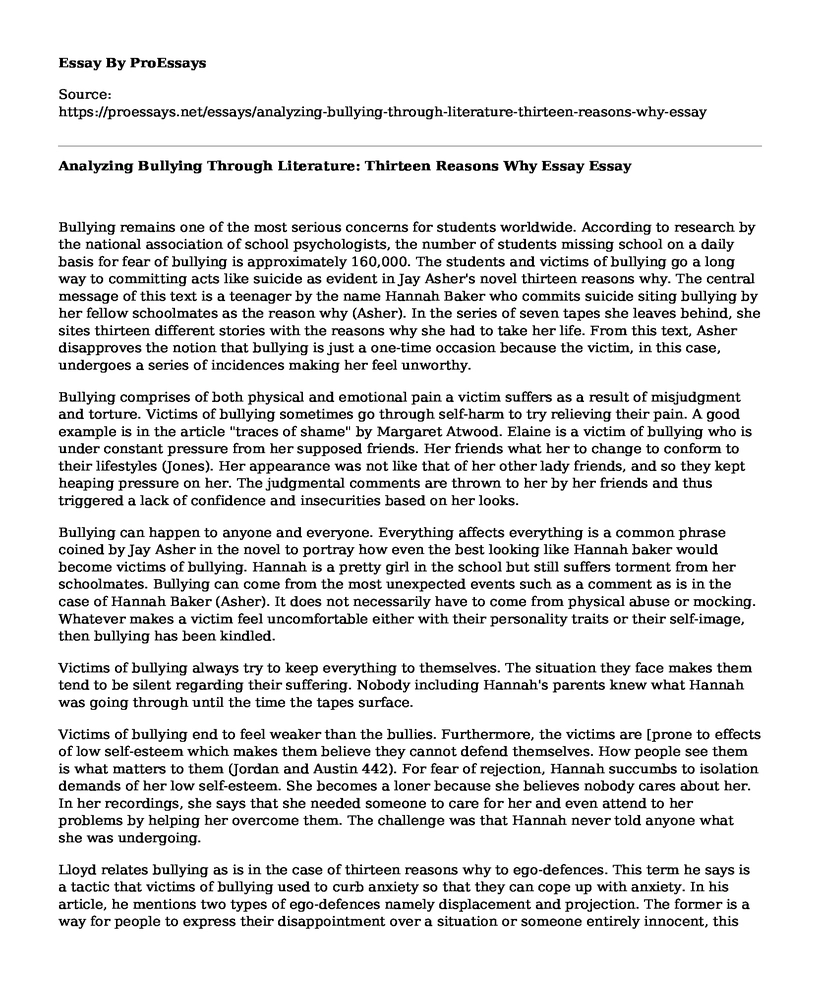Bullying remains one of the most serious concerns for students worldwide. According to research by the national association of school psychologists, the number of students missing school on a daily basis for fear of bullying is approximately 160,000. The students and victims of bullying go a long way to committing acts like suicide as evident in Jay Asher's novel thirteen reasons why. The central message of this text is a teenager by the name Hannah Baker who commits suicide siting bullying by her fellow schoolmates as the reason why (Asher). In the series of seven tapes she leaves behind, she sites thirteen different stories with the reasons why she had to take her life. From this text, Asher disapproves the notion that bullying is just a one-time occasion because the victim, in this case, undergoes a series of incidences making her feel unworthy.
Bullying comprises of both physical and emotional pain a victim suffers as a result of misjudgment and torture. Victims of bullying sometimes go through self-harm to try relieving their pain. A good example is in the article "traces of shame" by Margaret Atwood. Elaine is a victim of bullying who is under constant pressure from her supposed friends. Her friends what her to change to conform to their lifestyles (Jones). Her appearance was not like that of her other lady friends, and so they kept heaping pressure on her. The judgmental comments are thrown to her by her friends and thus triggered a lack of confidence and insecurities based on her looks.
Bullying can happen to anyone and everyone. Everything affects everything is a common phrase coined by Jay Asher in the novel to portray how even the best looking like Hannah baker would become victims of bullying. Hannah is a pretty girl in the school but still suffers torment from her schoolmates. Bullying can come from the most unexpected events such as a comment as is in the case of Hannah Baker (Asher). It does not necessarily have to come from physical abuse or mocking. Whatever makes a victim feel uncomfortable either with their personality traits or their self-image, then bullying has been kindled.
Victims of bullying always try to keep everything to themselves. The situation they face makes them tend to be silent regarding their suffering. Nobody including Hannah's parents knew what Hannah was going through until the time the tapes surface.
Victims of bullying end to feel weaker than the bullies. Furthermore, the victims are [prone to effects of low self-esteem which makes them believe they cannot defend themselves. How people see them is what matters to them (Jordan and Austin 442). For fear of rejection, Hannah succumbs to isolation demands of her low self-esteem. She becomes a loner because she believes nobody cares about her. In her recordings, she says that she needed someone to care for her and even attend to her problems by helping her overcome them. The challenge was that Hannah never told anyone what she was undergoing.
Lloyd relates bullying as is in the case of thirteen reasons why to ego-defences. This term he says is a tactic that victims of bullying used to curb anxiety so that they can cope up with anxiety. In his article, he mentions two types of ego-defences namely displacement and projection. The former is a way for people to express their disappointment over a situation or someone entirely innocent, this makes them feel better about themselves (Lloyd). The latter works by people attributing their mishaps and flaws to others within or even without their circle. This is evident if thirteen reason why when the character Jessica is placed in the "who's not hot" column alongside Hannah.
Lastly, Angelica Papadaki argues that bullying in the female context by their male counterparts is as a result of female sexual objectification. This she argues that is a product of over consumption of pornographic material. Objectification means that the only thing that matters to a male is the woman's body and not their personality traits, their values and their beliefs (Papadaki 332). Alex's list objectifies Hannah in the article thirteen reason why. Tyler is also obsessed with Hannah's body and not her personality traits. She receives public sexual harassment by Marcus and gets raped by Bryce. These incidences portray objectification.
Works cited
Asher, Jay. Th1rteen Reasons Why. 2nd ed. New York: Razorbill, 2011. Print.
Jones, Bethan. "Traces Of Shame: Margaret Atwood's Portrayal Of Childhood Bullying And Its Consequences In Cat's Eye." Critical Survey 20.1 (2008): n. pag. Web. 22 July 2018.
Jordan, Karin, and James Austin. "A Review Of The Literature On Bullying In U.S. Schools And How A Parent-Educator Partnership Can Be An Effective Way To Handle Bullying." Journal of Aggression, Maltreatment & Trauma 21.4 (2012): 440-458. Web.
Lloyd, Anna. A Study Of Childhood Trauma And Bullying In Margaret Atwood's Cat'S Eye. Lund University, 2012. Print.
Papadaki, Evangelia. "Sexual Objectification: From Kant To Contemporary Feminism." Contemporary Political Theory 6.3 (2007): 330-348. Web. 22 July 2018.
Cite this page
Analyzing Bullying Through Literature: Thirteen Reasons Why Essay. (2022, Jun 30). Retrieved from https://proessays.net/essays/analyzing-bullying-through-literature-thirteen-reasons-why-essay
If you are the original author of this essay and no longer wish to have it published on the ProEssays website, please click below to request its removal:
- Paper Example of Annotated Bibliography on Elder Abuse
- Essay Sample on Greek Characterization
- Importance of Culinary Practices for Syrian Refugees in Egypt
- Essay Sample on Controlled Substance Identification
- Paper Example on Prevalence and Support for Domestic Violence Survivors Presenting at Emergency Departments
- Essay Example on OR Violence: Unwanted Abuse & Hostility in the Workplace
- Immigrants Encounter Police: Mistrust, Misjudgment, and Detentions - Essay Sample







